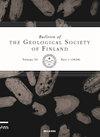北冰洋中部罗蒙诺索夫海岭MIS 4-3沉积记录的黏土矿物及Nd、Pb、Sr同位素物源
IF 1.3
4区 地球科学
Q2 GEOLOGY
引用次数: 0
摘要
将现代碎屑矿物来源技术应用于北冰洋中部罗蒙诺索夫山脊96/12-12pc沉积物岩心。这些技术包括定量粘土矿物学分析,以及从粘土组分中测定Nd、Pb和Sr同位素。粘土矿物组合和同位素特征描述了海洋同位素阶段(MIS)4-3转换期间的明显变化,对应于中魏克塞利期的消冰作用。这种过渡的特征是一层厚度为48厘米的均质深灰色粉质粘土层,具有独特的IRD浓度,形成了北冰洋中部沉积物的显著标志层。过渡层段中蒙脱石和高岭石含量的升高可能是西伯利亚玄武岩的风化产物,如Putorana高原,为卡拉海和拉普捷夫海西部的陆架提供食物。Nd和Sr同位素值与玄武岩的输入值一致,属于这些大陆架沉积物的同位素范围。MIS 4-3转换引起的不同灰色层Nd、Pb和Sr同位素数据的突然变化可能标志着明显的冰川消退事件。灰色层中粗碎屑的增加表明沉积机制发生了变化,具有强烈的冰山漂流成分。这种变化也可能与西伯利亚北部一个大型冰堰塞湖的融水突然释放有关。本文章由计算机程序翻译,如有差异,请以英文原文为准。
Clay mineral and Nd, Pb, and Sr isotope provenance of a MIS 4-3 sediment record from the Lomonosov Ridge, central Arctic Ocean
Modern techniques for detrital mineral provenance were applied to sediment core 96/12-1pc from the Lomonosov Ridge in the central Arctic Ocean. The techniques include quantitative clay mineralogy analysis combined with determination of Nd, Pb, and Sr isotopes from clay fraction. The clay mineral assemblage and the isotope signatures depict distinct changes during the Marine Isotope Stage (MIS) 4-3 transition corresponding to the Middle Weichselian deglaciation. This transition is characterised by a homogenous, 48 cm thick, dark grey, silty clay layer with a distinctive IRD concentration, forming a prominent marker bed for the central Arctic Ocean sediments. The elevated smectite and kaolinite contents in the transitional interval are possible weathering products of the Siberian basaltic rocks, such as the Putorana Plateau, feeding the shelves of the Kara Sea and the western Laptev Sea. The Nd and Sr isotope values are compatible with input from the basaltic rocks and fall within the isotopic range of sediments from these shelves. The abrupt changes in the Nd, Pb and Sr isotopic data from the distinct grey layer attributed to the MIS 4-3 transition likely mark a pronounced deglaciation event. An increase in coarse debris in the grey layer indicates a change in the sedimentation regime with a strong iceberg rafting component. This change may also be related to a sudden release of meltwater from a large ice-dammed lake in the northern Siberia.
求助全文
通过发布文献求助,成功后即可免费获取论文全文。
去求助
来源期刊
CiteScore
1.30
自引率
0.00%
发文量
5
审稿时长
>12 weeks
期刊介绍:
Bulletin of the Geological Society of Finland (BGSF) publishes research articles and short communications in all branches of geosciences. Contributions from outside Finland are welcome, provided that they contain material relevant to Finnish geology or are of general interest.

 求助内容:
求助内容: 应助结果提醒方式:
应助结果提醒方式:


